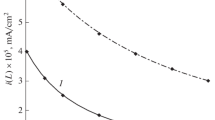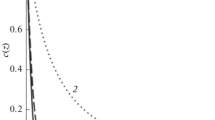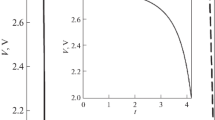Abstract
A distinctive feature of discharge of the lithium–oxygen power source (LOPS) with nonaqueous electrolyte is the filling of the positive electrode pores by lithium peroxide that is not soluble in the electrolyte and is characterized by low conductivity. Generally, the cathodic discharge process can be carried out only in a comparatively thin, several tens of micrometers, porous layer bordering on the gas phase. Therefore, the capacity per 1 cm2 of the outer cathode surface proves to be small. In this connection, the problem arises of developing more advanced LOPS and providing efficient performance of the active layers of the positive electrode at an increase in their thickness to achieve higher overall characteristics. In this work, the authors obtain experimental dependences of the positive electrode capacity on the active layer thickness and various current density values. Theoretical analysis of the obtained experimental data is performed. Here, the issues that are of considerable interest of the LOPS discharge theory are discussed.
Access this chapter
Tax calculation will be finalised at checkout
Purchases are for personal use only
Similar content being viewed by others
References
Tarasevich, M.R., Andreev, V.N., Korchagin, O.V., Tripachev, O.V.: Lithium-oxygen (air) batteries (state-of-the-art and perspectives). Prot. Met. Phys. Chem. Surf. 53, 1–48 (2017)
Tran, C., Yang, X.-Q., Qu, D.: Investigation of the gas-diffusion-electrode used as lithium/air cathode in non-aqueous electrolyte and the importance of carbon material porosity. J. Power Sources 195, 2057–2063 (2010)
Yang, X.-H., He, P., Xia, Y.-Y.: Preparation of mesocellular carbon foam and its application for lithium/air battery. Electrochem. Commun. 11, 1127–1130 (2009)
Laoire, C.O., Mukerjee, S., Abraham, K.M., Plichta, E.J., Hendrickson, M.A.: Elucidating the mechanism of oxygen reduction for lithium-air battery applications. J. Phys. Chem. C 113, 20127–20134 (2009)
Laoire, C.O., Mukerjee, S., Abraham, K.M., Plichta, E.J., Hendrickson, M.A.: Influence of nonaqueous solvents on the electrochemistry of oxygen in the rechargeable lithium − air battery. J. Phys. Chem. C 114, 9178–9186 (2010)
Mohazabrad, F., Wang, F., Li, X.: Experimental studies of salt concentration in electrolyte on the performance of Li-O2 batteries at various current densities. J. Electrochem. Soc. 163, A2623–A2627 (2016)
Liu, T., Leskes, M., Yu, W., Moore, A.J., Zhou, L., Bayley, P.M., Kim, G., Grey, C.P.: Cycling Li-O2 batteries via LiOH formation and decomposition. Science 350, 530–533 (2015)
Nomura, A., Ito, K., Kubo, Y.: CNT sheet air electrode for the development of ultra-high cell capacity in lithium-air batteries. Sci. Rep. 7, 45596 (2017)
Imanishi, N., Luntz, A.C., Bruce, P.G. (eds.): The Lithium-Air Battery. Fundamentals. Springer, New York (2014)
Abraham, K.M., Jiang, Z.: A polymer electrolyte-based rechargeable lithium/oxygen battery. J. Electrochem. Soc. 143, 1–5 (1996)
Beattie, S.D., Manolescu, D.M., Blair, S.L.: High-capacity lithium-air cathodes. J. Electrochem. Soc. 156, A44–A47 (2009)
Xiao, J., Wang, D., Xu, W., Wang, D., Williford, R.E., Liu, J., Zhang, J.-G.: Optimization of air electrode for Li/air batteries. J. Electrochem. Soc. 157, A487–A492 (2010)
Zhang, G.Q., Zheng, J.P., Liang, R., Zhang, C., Wang, B., Hendrickson, M., Plichta, E.J.: Lithium–air batteries using SWNT/CNF buckypapers as air electrodes. J Electrochem Soc 157, A953–A956 (2010)
Landa-Medrano, I., Pinedo, R., Ruiz de Larramendi, I., Ortiz-Vitoriano, N., Rojo, T.: Monitoring the location of cathode-reactions in Li-O2 batteries. J. Electrochem. Soc. 162, A3126–A3132 (2015)
Bogdanovskaya, V.A., Korchagin, O.V., Tarasevich, M.R., Andreev, V.N., Nizhnikovskii, E.A., Radina, M.V., Tripachev, O.V., Emets, V.V.: Mesoporous nanostructured materials for the positive electrode of a lithium-oxygen battery. Prot. Met. Phys. Chem. Surf. 54, 373–388 (2018)
Bogdanovskaya, V.A., Kol’tsova, E.M., Tarasevich, M.R., Radina, M.V., Zhutaeva, G.V., Kuzov, A.V., Gavrilova, N.N.: Highly active and stable catalysts based on nanotubes and modified platinum for fuel cells. Russ. J. Electrochem. 52, 723–734 (2016)
Bao, J., Hu, W., Bhattacharya, P., Stewart, M., Zhang, J.-G., Pan, W.: Discharge performance of Li-O2 batteries using a multiscale modeling approach. J. Phys. Chem. C 119, 14851–14860 (2015)
Pan, W., Yang, X., Bao, J., Wang, M.: Optimizing discharge capacity of Li-O2 batteries dy design of air-electrode porous structure: multifidelity modeling and optimization. J. Electrochem. Soc. 164, E3499–E3511 (2017)
Tarasevich, Y.Y.: Percolation: Theory, Applications, Algorithms. Editorial URSS, Moscow (2011)
Chirkov, Y.G.: Theory of porous electrodes: the percolation and a calculation of percolation lines. Russ. J. Electrochem. 35, 1281–1290 (1999)
Chirkov, Y.G., Rostokin, V.I., Skundin, A.M.: Computer modeling of positive electrode operation in lithium-ion battery: model of equal-sized grains, percolation calculations. Russ. J. Electrochem. 47, 71–83 (2011)
Sandhu, S.S., Fellner, J.P., Brutchen, G.W.: Diffusion-limited model for a lithium/air battery with an organic electrolyte. J. Power Sources 164, 365–371 (2007)
Read, J., Mutolo, K., Ervin, M., Behl, W., Wolfenstine, J., Driedger, A., Foster, D.: Oxygen transport properties of organic electrolytes and performance of lithium/oxygen battery. J. Electrochem. Soc. 150, A1351–A1356 (2003)
Dabrowski, T., Struck, A., Fenske, D., Maaβ, P., Ciacchi, L.C.: Optimization of catalytically active sites positioning in porous cathodes of lithium/air batteries filled with different electrolytes. J. Electrochem. Soc. 162, A2796–A2804 (2015)
Bogdanovskaya, V.A., Andreev, V.N., Chirkov, Y., Rostokin, V.I., Emets, V.V., Korchagin, O.V., Tripachev, O.V.: Effect of positive electrode structure on process of discharge of lithium-oxygen (air) power source. theory of monoporous cathode. Prot. Met. Phys. Chem. Surf. 54, 1015–1025 (2018)
Chirkov, Y., Andreev, V.N., Rostokin, V.I., Bogdanovskaya, V.A.: Discharge of lithium-oxygen power source: monoporous cathode theory and role of constant of oxygen consumption process. Altern. Energy Ecol. (ISJAEE) 4–6, 95–107 (2018)
Dyakonov, V.P.: Maple 10/11/12/13/14 in Mathematical Calculations (Russian Edition). DMK-Press, Moscow (2011)
Davis, J.H.: Differential Equations with Maple: An Interactive Approach. Birkhauser, Boston (2001)
Edwards, C.H., Penny, D.E.: Differential Equations and Boundary Value Problems: Computing and Modeling, 3rd edn. Moscow (2008)
Acknowledgement
The work was performed with support of Ministry of Science and Higher Education of Russian Federation.
Author information
Authors and Affiliations
Corresponding author
Editor information
Editors and Affiliations
Rights and permissions
Copyright information
© 2019 Springer Nature Switzerland AG
About this paper
Cite this paper
Chirkov, Y.G., Korchagin, O.V., Andreev, V.N., Bogdanovskaya, V.A., Rostokin, V.I. (2019). Discharge of Lithium–Oxygen Power Source: Effect of Active Layer Thickness and Current Density on Overall Characteristics of Positive Electrode. In: Silhavy, R., Silhavy, P., Prokopova, Z. (eds) Computational Statistics and Mathematical Modeling Methods in Intelligent Systems. CoMeSySo 2019 2019. Advances in Intelligent Systems and Computing, vol 1047. Springer, Cham. https://doi.org/10.1007/978-3-030-31362-3_7
Download citation
DOI: https://doi.org/10.1007/978-3-030-31362-3_7
Published:
Publisher Name: Springer, Cham
Print ISBN: 978-3-030-31361-6
Online ISBN: 978-3-030-31362-3
eBook Packages: Intelligent Technologies and RoboticsIntelligent Technologies and Robotics (R0)




